Matter
3rd grade CRCT Practice Heat flashcards. Physics for Kids: Friction. Science >> Physics for Kids What is friction?

Friction is the resistance of motion when one object rubs against another. Anytime two objects rub against each other, they cause friction. Friction works against the motion and acts in the opposite direction. Friction and Energy When one object is sliding on another it starts to slow down due to friction. The force F of friction pushes back on the block. Preventing Friction In some cases we want to prevent friction so it's easier to move. Using Friction Friction is also a great help to us. Experiment with Friction Different types of surfaces create different amounts of friction. There are 3 main factors that will influence the total amount of friction: 1) the roughness of the surfaces 2) the weight of the object 3) the surface area (how much is touching).
Science of Speed: Friction and Heat. What is Heat? How is it created?
Energy can take on many forms and can change from one form to another.
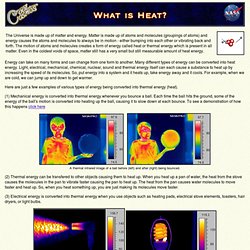
Heat and Transfer of Energy. Heat Transfer Interactive. How Does Heat Travel?
Heat can be transferred from one place to another by three methods: conduction in solids, convection of fluids (liquids or gases), and radiation through anything that will allow radiation to pass.
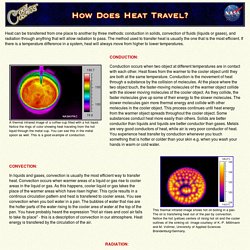
The method used to transfer heat is usually the one that is the most efficient. If there is a temperature difference in a system, heat will always move from higher to lower temperatures.
Thermodynamics & Heat: Energy Transfer. If there is a temperature difference in a system, heat will naturally move from high to low temperatures.

The place you find the higher temperature is the heat source. The area where the temperature is lower is the heat sink. When examining systems, scientists measure a number called the temperature gradient. The gradient is the change in temperature divided by the distance. The units are degrees per centimeter. Scientists have also discovered that objects that are good at giving off thermal radiation are also good at absorbing the same energy.
Convection, conduction, and radiation. Heat Transfer. Conduction, Convection, PowerPoint. Popcorn conduction convection radiation. What is Heat Energy SlideShare. My Favorite Heat Transfer Experiment. My students and I both love doing science experiments.

Last week we did my favorite experiment for introducing the concept of heat transfer. As I circulated among the groups, leaning in to ask questions and make observations, I was reminded of just why this experiment rocks my socks. Each group needs: * a medium sized container for cold water (I use a salad-sized clear plastic lunch tub) * a small container for warm water (I use a 5oz can of tomato sauce) * 2 thermometers * 1 cup of cold water * 1/2 cup of warm water When you give the signal, each group should set the warm water container into the cold water container like this: I watch the clock carefully and every minute I call out "Measure!
" At the end of the experiment we do a whole-class debrief, then the students graph their temperatures and write their conclusions about heat transfer on an accompanying index card.
This experiment is so so simple, but it seems to really stick with us. .
~ Amanda. The-heat-is-on powerpoint. Changing States of Matter by Ron Kurtus - Succeed in Understanding Physics. SfC Home > Physical Science > Physics > Matter > Explanation of changing the solid, liquid and gas states of matter by Ron Kurtus - Succeed in Understanding Physics.
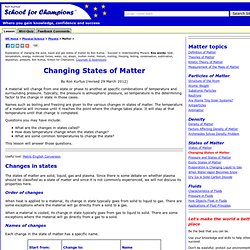
Key words: heat, temperature, energy, molecular forces, water, ice, steam, molten metal, Helium, melting, freezing, boiling, condensation, sublimation, deposition, pressure, Ron Kurtus, School for Champions. Copyright © Restrictions By Ron Kurtus (revised 29 March 2012) A material will change from one state or phase to another at specific combinations of temperature and surrounding pressure. Names such as boiling and freezing are given to the various changes in states of matter. Questions you may have include: What are the changes in states called? This lesson will answer those questions. Useful tool: Metric-English Conversion Changes in states.
Interactive Changing State. StudyJams. What is Water?
Liquid water is found in many places.
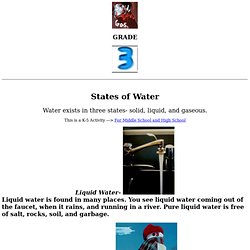
Matter. What is matter?
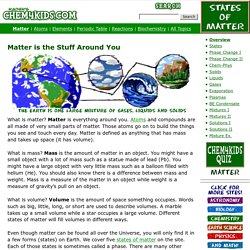
Matter is everything around you. Atoms and compounds are all made of very small parts of matter. Those atoms go on to build the things you see and touch every day. Matter is defined as anything that has mass and takes up space (it has volume).
Gases, Liquids, and Solids. Gases, Liquids, and Solids Gases, liquids and solids are all made up of atoms, molecules, and/or ions, but the behaviors of these particles differ in the three phases.

The following figure illustrates the microscopic differences. Note that: Particles in a: gas are well separated with no regular arrangement. Liquid are close together with no regular arrangement.
Solids, liquids and gases. Glass Picture. States of Matter Interactive. Air Magic Experiment. Air can be a big brain bender for first grade scientists.

After all, you can’t see it, you can’t taste it, and if you try to reach out and touch it, people might think you’re a little nuts. So how can your child tell it’s real? Some very, very smart people have wondered the same thing for centuries. One way we can tell that air exists is by observing some of the things it does. Air can fill a balloon, for example, and when it’s in the form of wind, it can move leaves and blow your hair around. What You Do: Have your child place the jar on a tabletop. When air comes into contact with objects, it flows around the contours of the object it hits, creating forces that can lift kites and blow out candles.
Science Projects for Kids: States of Matter"
Trying to comprehend the science of matter may seem complicated, but Science Projects for Kids: States of Matter makes understanding it easy and interesting.
Explore transitions between solid and liquid by making ice pops and rock candy. See what happens to soda pop gas in a balloon, and make a cloud in a bottle. Learn about the concept of surface tension by blowing soap bubbles, stretching the surface of water, and cutting and connecting water drops. You'll be surprised at how much you can learn about states of matter with these simple experiments. Gather a few materials from around the house, round up the kids, and have some science fun. Follow the links below to get started with science projects for kids that explain the states of matter: Solid to Liquid to Solid One of the easiest ways to understand how states of matter change is to make yummy ice pops.
Sugar Crystals on a String Enjoy the sweet rewards of this evaporation test. Homemade Water Purifier Soda Pop in a Balloon. Why do helium balloons float?
Air and Flight. 3.P.2. 3.P.3.










